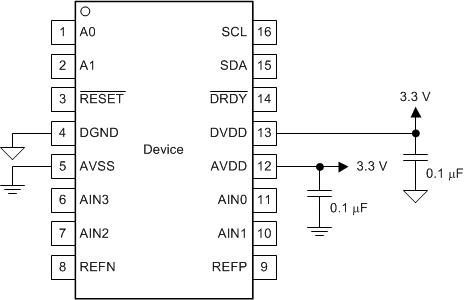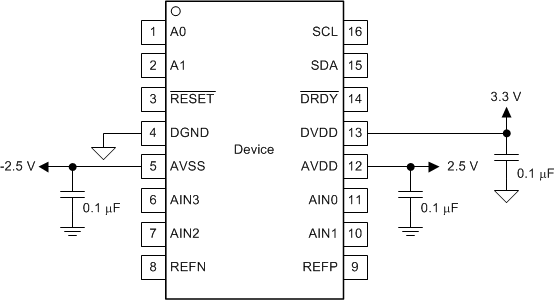SBAS751B October 2017 – October 2018 ADS122C04
PRODUCTION DATA.
- 1 Features
- 2 Applications
- 3 Description
- 4 Revision History
- 5 Pin Configuration and Functions
- 6 Specifications
- 7 Parameter Measurement Information
-
8 Detailed Description
- 8.1 Overview
- 8.2 Functional Block Diagram
- 8.3
Feature Description
- 8.3.1 Multiplexer
- 8.3.2 Low-Noise Programmable Gain Stage
- 8.3.3 Voltage Reference
- 8.3.4 Modulator and Internal Oscillator
- 8.3.5 Digital Filter
- 8.3.6 Conversion Times
- 8.3.7 Excitation Current Sources
- 8.3.8 Sensor Detection
- 8.3.9 System Monitor
- 8.3.10 Temperature Sensor
- 8.3.11 Offset Calibration
- 8.3.12 Conversion Data Counter
- 8.3.13 Data Integrity Features
- 8.4 Device Functional Modes
- 8.5 Programming
- 8.6
Register Map
- 8.6.1 Configuration Registers
- 8.6.2 Register Descriptions
- 9 Application and Implementation
- 10Power Supply Recommendations
- 11Layout
- 12Device and Documentation Support
- 13Mechanical, Packaging, and Orderable Information
Package Options
Mechanical Data (Package|Pins)
Thermal pad, mechanical data (Package|Pins)
- RTE|16
Orderable Information
10.2 Power-Supply Decoupling
Good power-supply decoupling is important to achieve optimum performance. As shown in Figure 80 and Figure 81, AVDD, AVSS (when using a bipolar supply), and DVDD must be decoupled with at least a 0.1-µF capacitor. Place the bypass capacitors as close to the power-supply pins of the device as possible using low-impedance connections. TI recommends using multi-layer ceramic chip capacitors (MLCCs) that offer low equivalent series resistance (ESR) and inductance (ESL) characteristics for power-supply decoupling purposes. For very sensitive systems, or for systems in harsh noise environments, avoiding the use of vias for connecting the capacitors to the device pins may offer superior noise immunity. The use of multiple vias in parallel lowers the overall inductance and is beneficial for connections to ground planes. Connect analog and digital grounds together as close to the device as possible.
 Figure 80. Unipolar Analog Power Supply
Figure 80. Unipolar Analog Power Supply  Figure 81. Bipolar Analog Power Supply
Figure 81. Bipolar Analog Power Supply